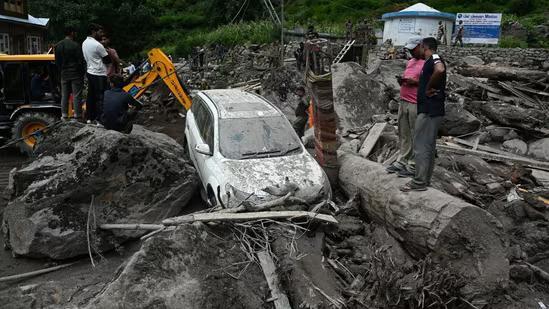
At least 60 killed, several trapped after cloudburst in J&K
A devastating cloudburst struck Chashoti village in Jammu and Kashmir’s Kishtwar district on Thursday afternoon, resulting in the loss of at least 60 lives and injuring over 100 people. The catastrophic event has left a trail of destruction, with several people feared trapped under the debris.
Chief Minister Omar Abdullah confirmed the fatalities, stating that the magnitude of the disaster is still unfolding. “I believe more than 500 people are still trapped under the debris in Kishtwar,” Jammu and Kashmir National Conference Chief Farooq Abdullah added, emphasizing the severity of the situation.
The cloudburst, which occurred around 2 pm on Thursday, brought with it heavy rainfall, strong winds, and flash flooding, causing widespread destruction in the affected areas. The rainwater, which was reportedly over 10 feet deep in some places, swept away homes, bridges, and roads, leaving a trail of devastation in its wake.
Eyewitnesses described the scene as “apocalyptic,” with entire villages reduced to rubble. “It was as if the world had come to an end,” said one resident, who wished to remain anonymous. “The sound of the cloudburst was like a thousand drums beating together. It was terrifying and we were lucky to escape with our lives.”
The cloudburst also caused significant damage to infrastructure, including electricity and communication networks. Power supply has been disrupted, and mobile phone services are currently unavailable in the affected areas.
Rescue teams, including the National Disaster Response Force (NDRF), the State Disaster Response Force (SDRF), and local volunteers, have been working tirelessly to evacuate the trapped people and provide aid to those affected. The Indian Air Force (IAF) has also been deployed to assist in the rescue efforts.
According to the latest reports, the cloudburst has affected over 20 villages in the district, with several areas still inaccessible due to the debris and floodwaters. The administration has set up relief camps in the affected areas, where food, shelter, and medical assistance are being provided to the displaced people.
The government has also announced a compensation package for the families of the deceased and the injured. Chief Minister Omar Abdullah has assured that all possible efforts will be made to rescue those trapped and provide assistance to those affected.
The cloudburst has also raised concerns about the impact of climate change on the region. The Kashmir valley is prone to natural disasters, including landslides, flash flooding, and cloudbursts, which are often exacerbated by climate change.
In recent years, the region has witnessed a significant increase in the frequency and intensity of such events, which has put a strain on the local infrastructure and emergency services. The government has been urged to take measures to mitigate the effects of climate change and improve disaster preparedness in the region.
The incident has also sparked concerns about the preparedness of the local administration to respond to such disasters. The government has been criticized for its slow response to the cloudburst, with many residents expressing frustration at the lack of timely assistance.
As the rescue efforts continue, the people of Jammu and Kashmir are bracing themselves for the long-term effects of the disaster. The cloudburst has not only caused loss of life and property but has also disrupted the daily lives of thousands of people.
In the face of such tragedy, it is essential that the government and the people come together to provide support and assistance to those affected. The community will need to rally together to rebuild and recover from this devastating event.






